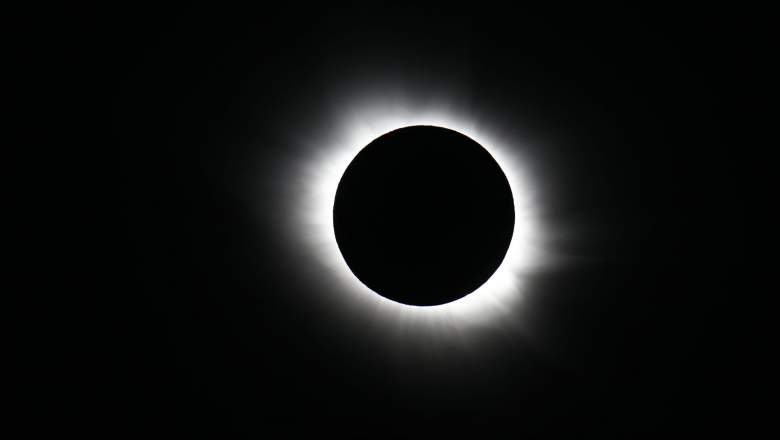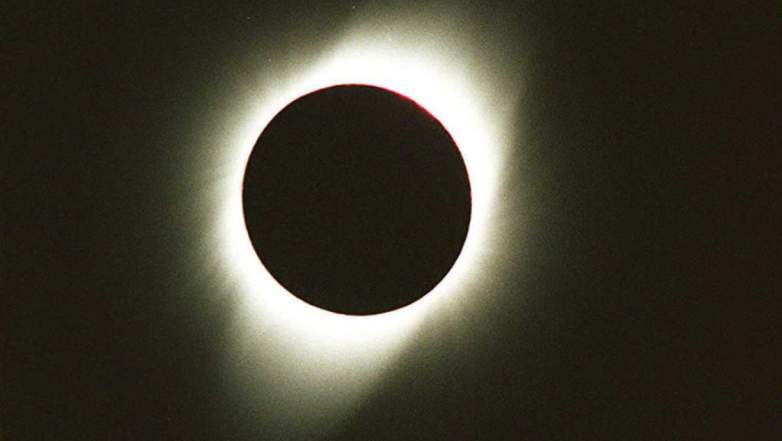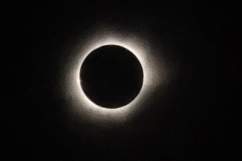
Getty A total solar eclipse can be seen in Svalbard, Longyearbyen, Norway, on March 20, 2015.
Solar eclipse 2017 arrives on August 21. What should you expect? How dark is it going to get?
That depends on where you live, of course, but here are some rules of thumb. According to Great American Eclipse, “It is a scene of unimaginable beauty; the Moon completely blocks the Sun, daytime becomes a deep twilight, and the Sun’s corona shimmers in the darkened sky.”
The states experiencing a total eclipse will undergo several minutes of darkness. “When the moon blots out the sun during Monday’s total solar eclipse..states in its path of totality, from Oregon to South Carolina, will be plunged into darkness for a few minutes,” The Los Angeles Times reports. It will be brief. “Totality lasts less than three minutes,” according to Science Alert.
According to NASA, “Over the course of 100 minutes, 14 states across the United States will experience more than two minutes of darkness in the middle of the day. Additionally, a partial eclipse will be viewable across all of North America.”
How dark will it get? Those in areas with a total eclipse will experience a phenomenon mirroring mid-twilight (if you’re in an area with a partial eclipse, we provide a method for determining the degree of your eclipse later in this article.)
“During a total eclipse, the sun’s corona is about as bright as a good full moon,” Weather.org reports. “Additionally, the edge of the moon’s shadow is, at most, only 35 miles away and considerable light will still come in from nearby areas not in total eclipse. Generally speaking, it will be as dark during a total eclipse as it is about a half hour after sunset, or as dark as mid-twilight.” You can see eclipse times within communities in the total eclipse path here.
The darkening will be gradual.
“Whether you are in the area of a partial eclipse or in the strip of totality, as the moon moves between the Earth and the sun, the sky will gradually begin to darken. If you are in the area of totality, the sky will grow dark as if it were nighttime, stars will appear and the temperature will drop,” KIRO7 reports.
According to AOL, it will resemble the darkness of nighttime. “…It will be dark — so dark that some animals seem to think it’s suddenly nighttime. During some previous eclipses, scientists have recorded cases of bats coming out to hunt, crickets starting to chirp and cows heading back to the barn.”
The Times notes, “The brief event may be the closest connection most of us will have to the dark sky our ancestors saw when they looked up.”
NASA explains, “Anyone within the path of totality can see one of nature’s most awe inspiring sights – a total solar eclipse. This path, where the moon will completely cover the sun and the sun’s tenuous atmosphere – the corona – can be seen, will stretch from Salem, Oregon to Charleston, South Carolina. Observers outside this path will still see a partial solar eclipse where the moon covers part of the sun’s disk.”
According to Time Magazine, “The total solar eclipse will begin in Lincoln Beach, Ore. at 10:16 a.m. PST. It will then move toward the East Coast, and end near Columbia, S.C. at about 2:44 p.m. EST.”
How dark it will get during a partial eclipse depends on where you live. However, there’s a way to find out how much of the eclipse you will see.
Curious if you’re in the total eclipse or partial eclipse path? The Courier Journal has a great interactive graphic that allows you to find out how much of the eclipse you will see where you live. Just input your city or zip code. The site will generate a percentage of how much the moon will cover the sun in your area, which will affect how dark it will get. (We tried it and were told we will see the moon cover 83.6% of the sun; the site also gives you the best times to see it and the duration.) “Although the path of totality will only be visible along a narrow portion of the country, most people outside of the band will see a near-total or partial eclipse,” The Courier Journal reports.
According to Business Insider, the eclipse will simulate darkness on various planets. For example, the site reports, using data from cartographer Michael Zeiler, “Washington DC, for example, is somewhere between Mars and Ceres, the largest dwarf planet in the solar system, when it comes to darkness — or 57% to 87% dimmer than normal.” This site has a step-by-step detailing of what you will see.

GettyThe view of a total solar eclipse in 1995.
NASA says it’s a myth that the moon turns completely black during a solar eclipse. Instead, you will be treated to a phenomenon known as “earthshine.”
“Look at the first quarter moon and you will discover that the dark lunar surface beyond the crescent is weakly illuminated,” NASA explains. “This is because, as viewed from the moon, Earth is very bright in the sky and its weak light is enough to turn the lunar surface a pale milky white. This is called earthshine, and the same thing applies during a total solar eclipse. Most of Earth’s surface is actually in broad daylight off the path of totality, and from the moon it would be in full phase, shining down on the lunar surface at its brightest. So, during a total solar eclipse, the lunar surface will be dimly seen due to earthshine, surrounded by the much more brilliant corona of the sun!”
According to CNN, “The total eclipse begins on the West Coast just after 10 a.m. PT and ends on the East Coast a little before 3 p.m. ET.”

NASA
The weather forecast in your area is also going to affect your view of the solar eclipse. Reports GreatAmericanEclipse, “Any location along the path of totality from Oregon to South Carolina can enjoy good weather on eclipse day, but the western half of the United States, especially from the Willamette Valley of Oregon to the Nebraska Sandhills, will enjoy the very best weather odds.” The site has some great maps too.
What if you’re in an airplane during the eclipse? The sky might look blacker. “The sky is that much clearer and that much blacker. And that makes the corona that much brighter and more electric. It’s really an electric-looking phenomenon,” reports Science Alert.
Remember not to view the solar eclipse without solar eclipse glasses that are certified. It can severely damage your eyes. You can view safety precautions here at the NASA safety page.
